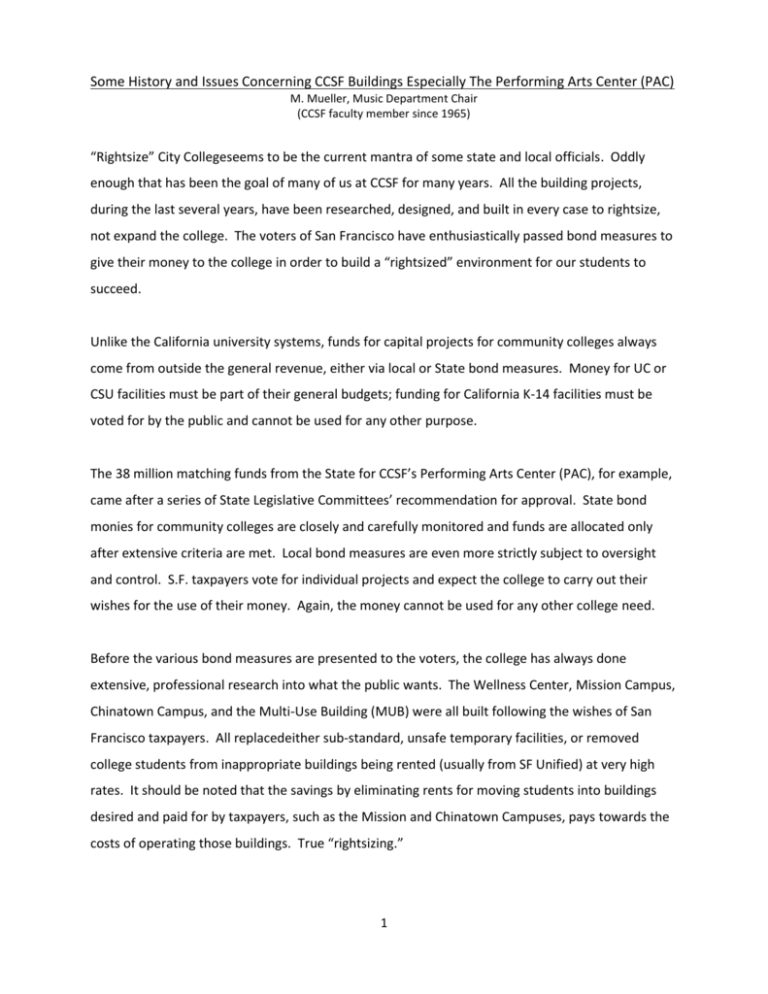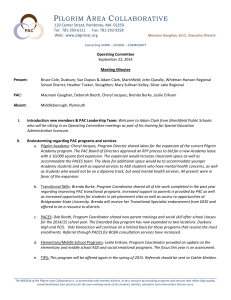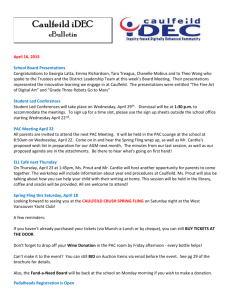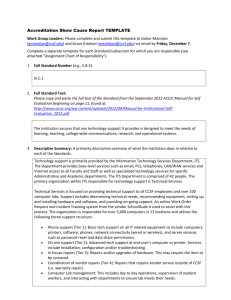Some History and Issues Concerning CCSF Buildings Especially
advertisement

Some History and Issues Concerning CCSF Buildings Especially The Performing Arts Center (PAC) M. Mueller, Music Department Chair (CCSF faculty member since 1965) “Rightsize” City Collegeseems to be the current mantra of some state and local officials. Oddly enough that has been the goal of many of us at CCSF for many years. All the building projects, during the last several years, have been researched, designed, and built in every case to rightsize, not expand the college. The voters of San Francisco have enthusiastically passed bond measures to give their money to the college in order to build a “rightsized” environment for our students to succeed. Unlike the California university systems, funds for capital projects for community colleges always come from outside the general revenue, either via local or State bond measures. Money for UC or CSU facilities must be part of their general budgets; funding for California K-14 facilities must be voted for by the public and cannot be used for any other purpose. The 38 million matching funds from the State for CCSF’s Performing Arts Center (PAC), for example, came after a series of State Legislative Committees’ recommendation for approval. State bond monies for community colleges are closely and carefully monitored and funds are allocated only after extensive criteria are met. Local bond measures are even more strictly subject to oversight and control. S.F. taxpayers vote for individual projects and expect the college to carry out their wishes for the use of their money. Again, the money cannot be used for any other college need. Before the various bond measures are presented to the voters, the college has always done extensive, professional research into what the public wants. The Wellness Center, Mission Campus, Chinatown Campus, and the Multi-Use Building (MUB) were all built following the wishes of San Francisco taxpayers. All replacedeither sub-standard, unsafe temporary facilities, or removed college students from inappropriate buildings being rented (usually from SF Unified) at very high rates. It should be noted that the savings by eliminating rents for moving students into buildings desired and paid for by taxpayers, such as the Mission and Chinatown Campuses, pays towards the costs of operating those buildings. True “rightsizing.” 1 The Performing Arts Center (PAC) was supposed to have been built along with the above facilities. Indeed, in the various researches done of San Francisco voters, this is the building they really want and have wanted for decades. A 1965 articlein the S.F. Examiner asked where is City College’s auditorium? A few years later, Dr. Clarence Mangham, Vice Chancellor of Facilities in the State Chancellor’s office also pointed out that CCSF was, in fact, an “incomplete campus,” which was, in the days of valid application of criteria, an accreditation “deficiency.” Are we ready to say to the people of S.F. and the people of California that we don’t intend to follow their wishes to build a PAC for students and the community? The situation is, of course, complicated by the current accreditation cloud over CCSF, but shouldn’t this last project of the current local and State bonds for academic building upgrades be respected? Certainly at least until the June 2014 deadline for the use of the State approved funds? Any future City College of any size will still need this facility to complete the campus, so the fate of the building and CCSF should stay joined for this year. Here are some issues involving the PAC (in no particular order) Over $20,000,000 has already been spent on the project involving land preparation, energy use, and designs. The building has been “shovel-ready” for months. Because then Chancellor Fisher pulled the contract to bid out the project off the agenda in the middle of last October’s Board of Trustee meeting, the college was forced by her action to miss the opportunity to hire an “at risk” construction firm which would have bid-out and locked-in construction costs at highly affordable pre-2013 levels. The project was set to break ground June 2013. The project now needs to break ground by June 2014 to retain the $38,000,000 in State matching funds. If the $38,000,000 is not used by CCSF, it goes back to the State to give to another school (and therefore not to local construction workers). The delay caused by Chancellor Fisher will probably result in the college missing the Sept. 2013 deadline for building the PAC under the current building permits from the Division of the State Architect (DSA). A design update for a new DSA permit is “doable” according to the PAC architects, but will need to be done ASAP, because of the review and approval process involved. Money for this update is available in the PAC bond money; it would not come from the general fund. 2 The 50 plus million now dedicated through the local bond criteria forthe PAC cannot be used for other CCSF projects, no matter how worthy, unless they were voted for already. A new bond measure must be passed to address various new capital project needs for CCSF. And how likely will that be when the press will no doubt trumpet that the college threw away one hundred million dollars of support for what voters wanted and paid for?! It is estimated that whenChancellor Fisher did not allowthe college to lock-in more reasonable construction costs, the project now going out to bid, due to construction market escalation is estimated to cost on the order of an additional 5 million. Again the architects have declared this to be “doable” under a redesign process called “value-engineering” and again the cost to redesign is within valid bond expense, not college budgets, and must be done ASAP. Current Chancellor Thelma Scott-Skillman has always made her objection to PAC an issue of the college not having done a professional assessment of costs to run the building. Fortunately, we did pay consultant David Dial for such an assessment in 2005. With very slight updating to today’s dollars, the report should fulfill now, as it did then, its role as an advisory document. The PAC is designed with 3 performance spaces seating 650, 200, and 150 respectively, and also includes 3 large rooms which could each hold 150 to 200 people (there are several additional classroom size spaces). The six large spaces are all “rentable” and would generate more than enough to cover annual custodian costs. The six large rooms in PAC would almost double the number of such sized rooms now on campus and allow a far more efficient scheduling of large lecture classes taught by fewer faculty. This seems one of the big goals of current “enrollment management” processes. Other community colleges have the proportionately appropriate numbers of large rooms at their campuses. CCSF does not. The badly conceived but obvious move these days to deny students their necessary training in the arts should not negate the building of the PAC . All rooms can be used for all disciplines. The Arts/Entertainment Industry is one of California’s major employers. In addition, many of the high tech advancements in many fields frequentlycome from people who have performing and visual arts background and training. The PAC building has been designed for 3 state-of-the-art (notice how we acknowledge “art” in any statement about cutting edge technology) education and training. The PAC design has already won major national and state awards, especially for its green attributes. The building has been designed to high energy performance requirements and is targeting LEED Gold Certification(Leadership in Energy & Environmental Design), a level unique among performing arts buildings. In fact, part of the 20 million already spent on PAC involves the hundred plus geo-thermal wells dug under the reservoir parking area and the conversion rooms repositioned under the MUB. These rooms were to be built under PAC and were designed to serve both buildings, but MUB got its funding first, so the basement of PAC was shifted to the addition of a basement for MUB. If the PAC does need a fund-raising effort to meet any additional capital fund needs, or to endow building costs beyond revenue generated by rental fees and/or extra FTES State revenue generated by scheduling the large rooms under enrollment management, a capital campaign was well underway a few years ago. Two consultants were hired to lay out the steps needed and also prepared publicity. It would take very little effort to finish their work (and get some return on our investment.) The materials are all in boxes and available. Many people, especially connected personally and professionally to the CCSF music and theatre arts faculty, have been or are being contacted to support the PAC, in particular, and the Performing Arts at City College in general. A partial list (as of 8-20-13) currently includes: Laurie Anderson * Tippi Hedren * Sarah Cahill/KALW * Lawrence Ferlinghetti * Danny Glover * Kronos String Quartet * Guy Carson/Cafe Du Nord * ROVA Saxophone Quartet * Del Sol String Quartet * Chanticleer Choir * Philharmonia Baroque * Michael Ward/Hyde Street Studios * Marina Hotchkiss/LINES Ballet * Ron Turner/Last Gasp of San Francisco * John Santos 4








